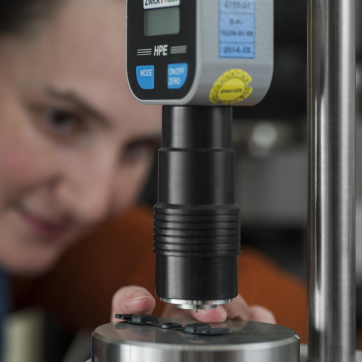
Hardness (DH)
The Hardness (DH) of an elastomer is the quantification of its resistance to perpetual indentation. A durometer is commonly used for testing rubber samples. It consists of 12 scales that can be used to specify the hardness of the following rubber samples:
| Type | Examples of Materials | Durometer Hardness |
| A | Natural rubber, thermoplastic elastomers, and soft vulcanized rubber. | 20-90 A |
| B | Moderately hard rubber and thermoplastic elastomers. | Above 90 A and Below 20 D |
| C | Medium-hard rubber and thermoplastic elastomers. | Above 90 B and Below 20 D |
| D | Hard rubber and thermoplastic elastomers. | Above 90 A |
| DO | Moderately hard rubber and thermoplastic elastomers. | Above 90 C and Below 20 D |
| M | Thin rubber and thermoplastic elastomers. | 20-85 A |
| O | Soft rubber and thermoplastic elastomers. | Below 20 DO |
| OO | Extremely soft rubber and thermoplastic elastomer. | Below 20 O |
Hardness Measurement

The durometer can measure the depth of an indentation in the sample. The measurement is achieved by applying force on a presser foot. The depth depends on the:
- The shape of the presser foot
- Duration of the test
- The hardness of the sample
- The viscoelastic properties of the sample
ASTM D2240 durometers can measure the original or indentation hardness over a certain period of time. The test requires constant force, without shock, and measuring the depth of the indentation. For a timed hardness, the force needs to be applied for a specific period, before taking the measurement.
The hardness of a sample can be determined by using one of twelve durometer scales. The test is based on the penetration of a certain type of indentor. The indentation hardness is inversely proportional to the penetration and depends on the viscoelastic behavior and the elastic modulus of the sample.
Note that the:
- Applied force and the geometry of the indentor can influence the measurement. The test method is intended mainly for control purposes.
- The calculated indentation hardness is not related to the fundamental property of the sample tested.
ASTM D2240 Hardness & Elastic Modulus
Measuring the DH of a sample can be achieved using the following specific formula:
Where,
SA – Type A hardness
SD – Type D hardness
E – Young’s modulus

Hardness (DH)
The Hardness (DH) of an elastomer is the quantification of its resistance to perpetual indentation. A durometer is commonly used for testing rubber samples. It consists of 12 scales that can be used to specify the hardness of the following rubber samples:
| Type | Examples of Materials | Durometer Hardness |
| A | Natural rubber, thermoplastic elastomers, and soft vulcanized rubber. | 20-90 A |
| B | Moderately hard rubber and thermoplastic elastomers. | Above 90 A and Below 20 D |
| C | Medium-hard rubber and thermoplastic elastomers. | Above 90 B and Below 20 D |
| D | Hard rubber and thermoplastic elastomers. | Above 90 A |
| DO | Moderately hard rubber and thermoplastic elastomers. | Above 90 C and Below 20 D |
| M | Thin rubber and thermoplastic elastomers. | 20-85 A |
| O | Soft rubber and thermoplastic elastomers. | Below 20 DO |
| OO | Extremely soft rubber and thermoplastic elastomer. | Below 20 O |
Hardness Measurement

The durometer can measure the depth of an indentation in the sample. The measurement is achieved by applying force on a presser foot. The depth depends on the:
- The shape of the presser foot
- Duration of the test
- The hardness of the sample
- The viscoelastic properties of the sample
ASTM D2240 durometers can measure the original or indentation hardness over a certain period of time. The test requires constant force, without shock, and measuring the depth of the indentation. For a timed hardness, the force needs to be applied for a specific period, before taking the measurement.
The hardness of a sample can be determined by using one of twelve durometer scales. The test is based on the penetration of a certain type of indentor. The indentation hardness is inversely proportional to the penetration and depends on the viscoelastic behavior and the elastic modulus of the sample.
Note that the:
- Applied force and the geometry of the indentor can influence the measurement. The test method is intended mainly for control purposes.
- The calculated indentation hardness is not related to the fundamental property of the sample tested.
ASTM D2240 Hardness & Elastic Modulus
Measuring the DH of a sample can be achieved using the following specific formula:
Where,
SA – Type A hardness
SD – Type D hardness
E – Young’s modulus








